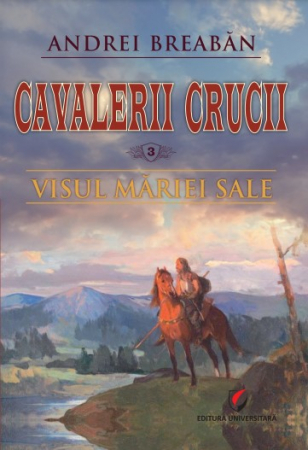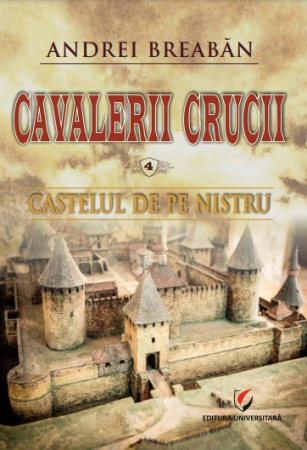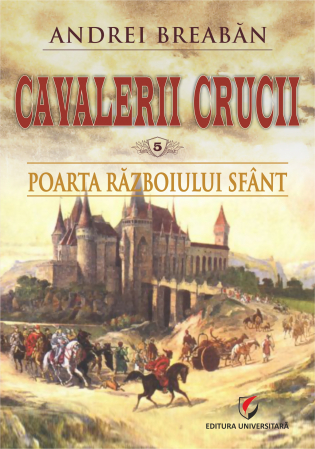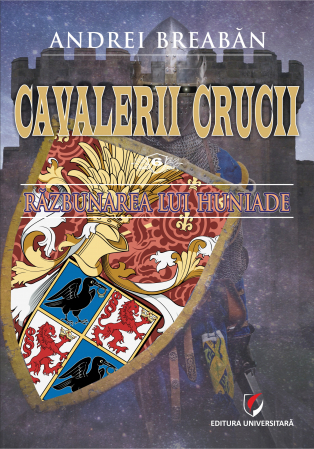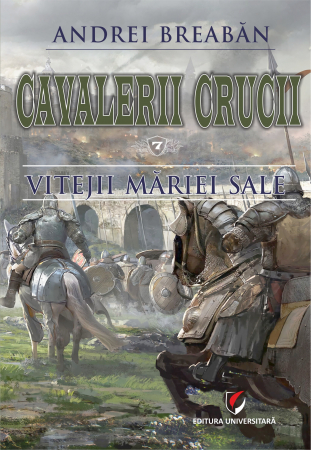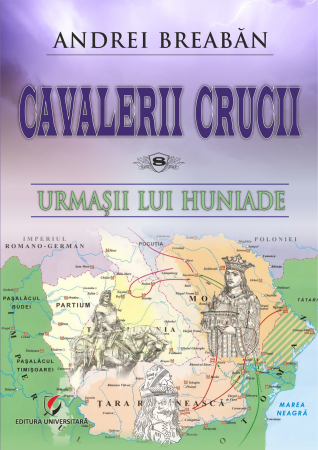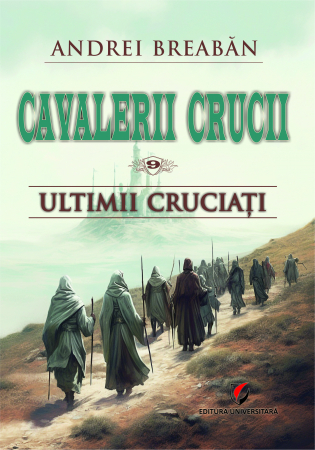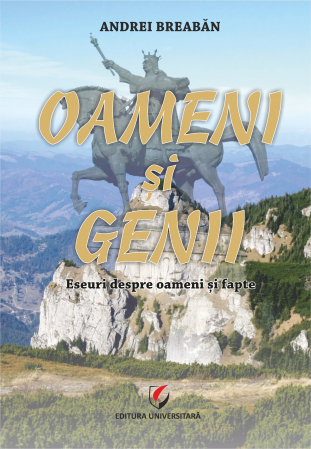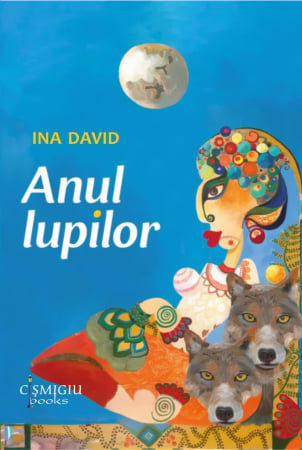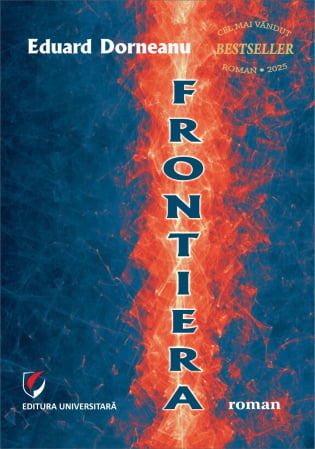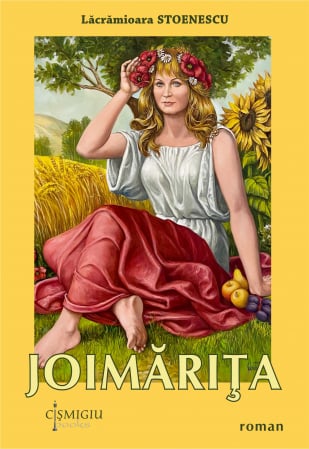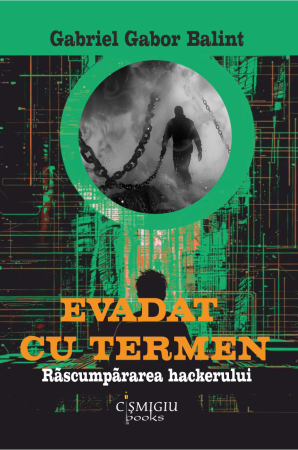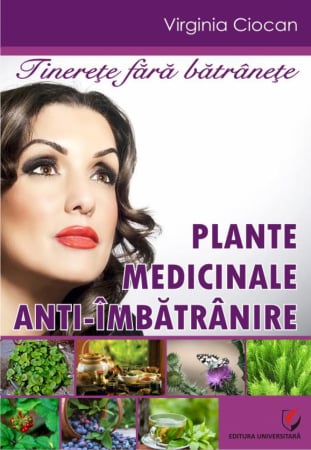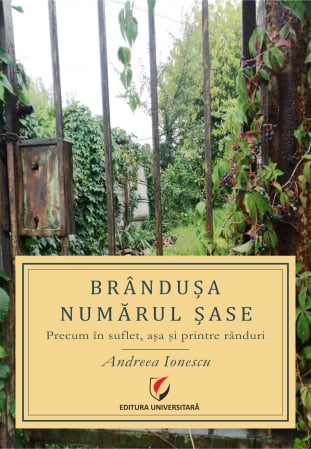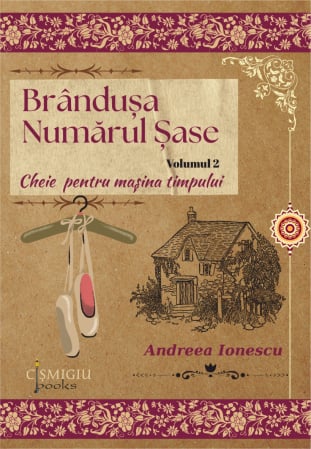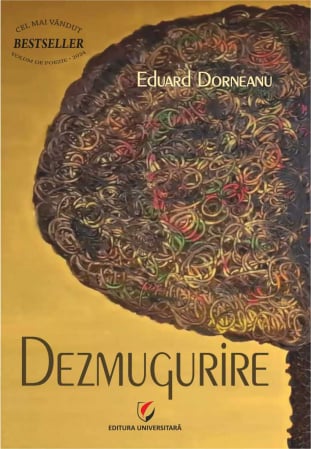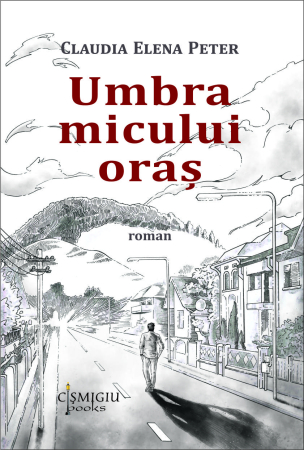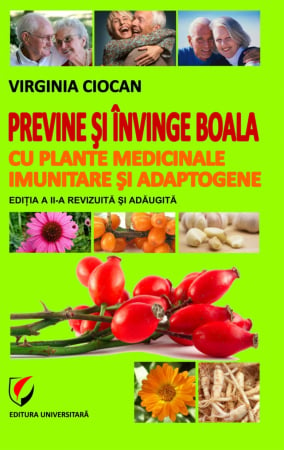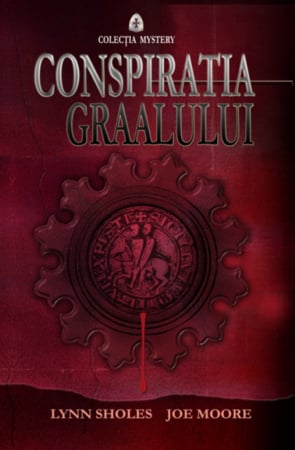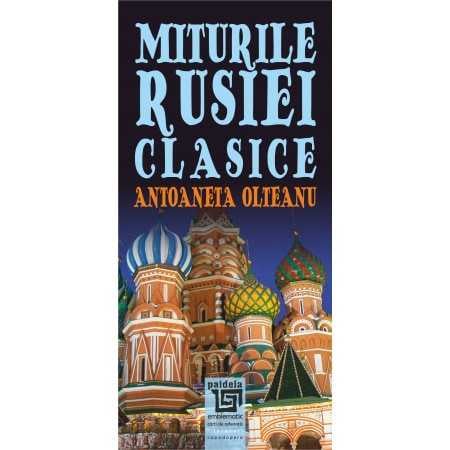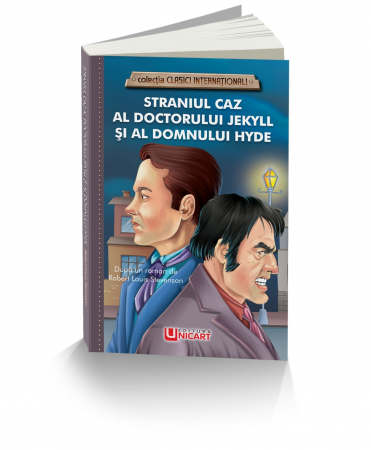Manuscript proposals: [email protected] / 0745 204 115 //// Tracking orders Individuals / Sales: 0745 200 357 / Orders Legal entities: 0721 722 783
Publisher: Editura Universitară
Author: Andrei Breaban
Publisher year: 2024
Edition: I
Pages: 444
ISBN: 978-606-28-1883-8
DOI: 10.5682/9786062818838
Product Code:
9786062818838
Do you need help?
0745 200 357
- Description
- Download (1)
- Authors
- Content
- More details
- Reviews (0)
Beyond the reconstruction of the era and the emblematic figure of Stephen the Great, the pivotal theme of the Romanian cycle remains what the author himself calls the Dacia Project. The ten Romanians have, in fact, three protagonists, Iancu de Hunedoara, Vlad Drago and Ștefan cel Mare, Andrei Breabăn pursuing an epic synthesis of an era and the identification of the idea around which the three rulers of the Romanian countries will have gathered: this is The Dacia Project that Iancu de Hunedoara builds, before Mihai Viteazul, at the suggestion of some writings of his time, which he shows to Bogdan, the son of Alexander the Good and the father of Stephen the Great, when he wandered in Transylvania...
Knights of the Cross. At the gates of destiny is a historical novel where the facts, the events, the action of the protagonists, the plot are important not once in the plot of the "action" novel or, as it was once said, "of head and sword". From this point of view, Andrei Breabăn's novel is impeccably written, in a tight narrative logic and in a flawless documentation, for the benefit, first of all, of the amateur reader of historical novels and adventures. The charm of the narrative of the author from Suceava is given, above all, by the reconstruction of the atmosphere of the era, with its special perfume, rediscovered in well-documented and inspired evocations. It seems that Andrei Breabăn has a huge camera that pans the times, people and places of 15th century Moldova, fixing in clear frames not only the throne room, the princely court of Suceava, Vaslui and Bacău and the house in Borzești, but and, for example, one of the inns of that time...
The Stefanian epic is, for good measure, the work of a good deacon, "present at the right time at the right place", in the beautiful tradition of the Moldavian chroniclers.
Ioan Holban
Knights of the Cross. At the gates of destiny is a historical novel where the facts, the events, the action of the protagonists, the plot are important not once in the plot of the "action" novel or, as it was once said, "of head and sword". From this point of view, Andrei Breabăn's novel is impeccably written, in a tight narrative logic and in a flawless documentation, for the benefit, first of all, of the amateur reader of historical novels and adventures. The charm of the narrative of the author from Suceava is given, above all, by the reconstruction of the atmosphere of the era, with its special perfume, rediscovered in well-documented and inspired evocations. It seems that Andrei Breabăn has a huge camera that pans the times, people and places of 15th century Moldova, fixing in clear frames not only the throne room, the princely court of Suceava, Vaslui and Bacău and the house in Borzești, but and, for example, one of the inns of that time...
The Stefanian epic is, for good measure, the work of a good deacon, "present at the right time at the right place", in the beautiful tradition of the Moldavian chroniclers.
Ioan Holban
-
Knights of the Cross - Volume 1. At the gates of destiny - Andrei Breaban
Download
ANDREI BREABAN
Preface – The Dacia Project, by Ioan Holban / 5
Chapter 1 Poor in a rich country / 11
Chapter 2 The Child with Golden Hair / 30
Chapter 3 Justice of Stefan Vodă / 56
Chapter 4 Voivodship Family of Moldavia / 82
Chapter 5 Monk Aaron / 101
Chapter 6 Iancu de Hunedoara / 124
Chapter 7 The Feast of the Prophet Elijah / 149
Chapter 8 Prophet Elijah at the Royal Court / 163
Chapter 9 Days of Mourning in the Seat Citadel of Moldavia / 176
Chapter 10 War Preparations / 193
Chapter 11 Vlad – Drago's son / 209
Chapter 12 Olecho, the crosser of carcasses / 224
Chapter 13 Of the mouse and the cat / 237
Chapter 14 A difficult road / 253
Chapter 15 The Battle of Lipovăț / 272
Chapter 16 Peace negotiations / 284
Chapter 17 Battle of Crasna / 299
Chapter 18 Winter Holidays / 319
Chapter 19 Easter Holidays at Sambor / 335
Chapter 20 Secret intrigues at the Castle of the Seat / 351
Chapter 21 Secret fabrics at the Hotin Fortress and Parczow / 365
Chapter 22 Autumn over the Country of Moldavia / 386
Chapter 23 Night party at Reuseni / 399
Chapter 24 The Reuseni Murder / 413
Afterword to the Gates of Destiny - beginning of Epic, by Marius Chelaru / 435
Bibliography / 437
Chapter 1 Poor in a rich country / 11
Chapter 2 The Child with Golden Hair / 30
Chapter 3 Justice of Stefan Vodă / 56
Chapter 4 Voivodship Family of Moldavia / 82
Chapter 5 Monk Aaron / 101
Chapter 6 Iancu de Hunedoara / 124
Chapter 7 The Feast of the Prophet Elijah / 149
Chapter 8 Prophet Elijah at the Royal Court / 163
Chapter 9 Days of Mourning in the Seat Citadel of Moldavia / 176
Chapter 10 War Preparations / 193
Chapter 11 Vlad – Drago's son / 209
Chapter 12 Olecho, the crosser of carcasses / 224
Chapter 13 Of the mouse and the cat / 237
Chapter 14 A difficult road / 253
Chapter 15 The Battle of Lipovăț / 272
Chapter 16 Peace negotiations / 284
Chapter 17 Battle of Crasna / 299
Chapter 18 Winter Holidays / 319
Chapter 19 Easter Holidays at Sambor / 335
Chapter 20 Secret intrigues at the Castle of the Seat / 351
Chapter 21 Secret fabrics at the Hotin Fortress and Parczow / 365
Chapter 22 Autumn over the Country of Moldavia / 386
Chapter 23 Night party at Reuseni / 399
Chapter 24 The Reuseni Murder / 413
Afterword to the Gates of Destiny - beginning of Epic, by Marius Chelaru / 435
Bibliography / 437
Andrei Breabăn's Ștefanian epic reached book number eight, Descendants of Huniade, recently published. At this point, the prose writer returns to the first novels in the cycle to partially rewrite them, in the perspective of the lines of force of the entire narrative series, reprinting, here, the first book, Knights of the Cross. At the gates of destiny. Beyond the reconstruction of the era and the emblematic figure of Stephen the Great, the pivotal theme of the Romanian cycle remains what the author himself calls the Dacia Project. The eight novels have, in fact, three protagonists, Iancu de Hunedoara, Vlad Drago and Ștefan cel Mare, Andrei Breabăn pursuing an epic synthesis of an era and the identification of the idea around which the three rulers of the Romanian countries will have gathered: this is The Dacia project that Iancu de Hunedoara builds, before Mihai Viteazul, at the suggestion of some writings of his time, which he shows to Bogdan, the son of Alexander the Good and the father of Stephen the Great, when he wandered in Transylvania: " From the discussions he had with Iancu when he wandered in Transylvania, Bogdan understood that this great hero of Christianity had big and bold plans that only he could carry out. One day he showed him some notes of Pippo de Ozora, which was committed by Timișoara during the time of the Hungarian king Sigismund of Luxemburg, in which he talked about the common origin of the three countries inhabited by Wallachians, who speak the same language, on that Iancu dreamed of bringing them together again. He made great efforts to appoint faithful voivodes, both in Wallachia and in Moldavia, who, being subject to him, obeyed him like a prince. That is why he also helped him drive the lesi out of Moldavia, after Peter was lost in the battle on the Câmpia Mierlei (...) His name reached the lips of the pope in Rome who offered him the leadership of the anti-Ottoman crusades, obtaining then everything he dreamed of, from the title of count of Bistrita to the numerous estates received from King Vladislav as a reward for his deeds, rising to the position of commander of the royal banners, and after the king's death in the Varna crusade, he is elected of the Diet of the Kingdom governor of the Kingdom of Hungary, position similar to a prince. Precisely this position allows Iancu to change the voivodes in the three Romanian countries as he pleases, so that through their faith and obedience he can bring them together, thus trying to restore the project of the old Dacia that he learned about while he stayed in Rome and Milan, knowing that he was also interested in the Holy Father who learned about the bravery of the Wallachians in the battles with the pagans". Thus, the reasons why "Ianăș" supports the ascension and maintenance of the descendants of Alexandru cel Bun and Matei Basarab, Bogdan and Ștefan, then Vlad Drago, on the throne of Moldova and Wallachia are to secure loyal, strong allies in the battles against the Turks, but also the secret dream of ancient Dacia: "Both his position as governor of the Kingdom, as well as the international context and the specifics of the feudal arrangements of the time did not allow him to go further, and the defeat at the Mierlei Plain confused him and more the plans for the implementation of the Dacia project about which he had some discussions with the cardinal sent by the High Pontiff, who died in the battle. Energetic and self-confident, Iancu does not give up on this project, taking a first step towards its realization by imposing voivods who obey him as a master or a parent, as Bogdan Voievod expressed in the letter he sent him -a". Not only Iancu, but also his protégés assume this plan; Bogdan calls him "Maria sa Ianăș, our Crăișor, of the Vlachs", and the two young rulers, Ștefan and Vlad, feel the same way when they project the future ("Let's be happy while we can live the present and see what we can do for the future, to may it be good for us and our countries, which we owe to serve...", says Vlad) and in the common horizon of faith, in the "warmth of Christ's love", as Ștefan says.
Knights of the Cross. At the gates of destiny is a historical novel where the facts, the events, the action of the protagonists, the plot are important not once in the plot of the "action" novel or, as it was once said, "of head and sword". From this point of view, Andrei Breabăn's novel is impeccably written, in a tight narrative logic and in a flawless documentation, for the benefit, first of all, of the amateur reader of historical and adventure novels. The charm of the narrative of the author from Suceava is given, above all, by the reconstruction of the atmosphere of the era, with its special perfume, rediscovered in well-documented and inspired evocations. It seems that Andrei Breabăn has a huge camera that captures the times, people and places of 15th century Moldova, fixing in clear frames not only the throne room, the princely court of Suceava, Vaslui and Bacău and the house in Borzești, but and, for example, one of the inns of that time: "The wide courtyard of the La Hotară inn was full of people. Most of them were merchants and horsemen passing through Hotin, a border fair that made the transit through Ţara Leșeasca to Moldova or vice versa. Known as one of the best inns in Hotin for the tasty food that was prepared, it was attacked daily by dozens of customers who stopped to satisfy their hunger so they could continue on their way. At the entrance to the inn, they were greeted by a servant who received their horses to water them and satisfy their hunger, because the owners would be full in vain, if some of the animals they were carrying on their backs were not eaten. The guests sat down at the tables that were not occupied, arranged by the innkeeper during the summer in the yard, and if the group was larger, they joined two or three tables together, so that they would all be together, to get along with each other. That way, the food seemed tastier, not to mention the drink that the innkeeper sent by the bucket, after first offering a carafe of cold wine for tasting, fresh from the barrels he kept in the inn's deep cellars. He must have had a source of good wine, that all those who tasted of it asked for it to be brought to them until they had their fill. Or maybe it was just the heat of the summer days, which hastened to come this year a little faster than usual". The parties, with the customs, today, forgotten, like the cauldron: "When everyone has cooked to throw away, giggling and throwing glances to see who is putting what, the gypsy sits on a chair in front of the cauldron of cauldron, covers her head well with a blanket brought of the hosts, she takes in her right hand the rod brought specifically by her, with which she mixes the objects in the water, muttering all kinds of charms. Continuing to mutter and invoke the heathen gods, he takes each object out of the water in turn and tells his master what the gods augur for the future. The young people laugh and rejoice, trying to guess who the object in question belongs to. As she divined, the gypsy's breast swelled with the coins that those who received good news put on her. And she made sure that everyone received such prophecies, so that no one would leave the party upset and, in the coming year, the host would no longer invite her with the fortune-telling. The big boyars were following, curious to find out what news the rod gives them". Inspired, because it is very close to the prose writer from Suceava, the reconstruction of mountain life from Bucovina villages: "Livestock breeders sold curd and other products obtained from sheep, goats or cows in the Câmpulungului market, then they bought wheat, millet or other products that were not made in the mountain villages. From the merchants they procured their tools of all kinds, earthen pots of various sizes, valves, pots or wooden barrels, spoons and poles for chewing the milk, harnesses for horses and oxen, carts and horses for carrying hay or wood, but and beautiful rooms, especially for maids and maids. Such goods were mainly brought by merchants from Transylvania, who came to Moldova through Bistrita and paid the small customs duty in the village that received the name Vama, located not far from Câmpulung (...) The sheep collected the sheared wool and sold it in the fairs, this being bought by merchants who took it to skilled craftsmen to make warm vestments from it, which they then sold in the country, among the buyers being the mountaineers. In addition to wool, the furs of sheep and goats slaughtered for meat were also used, which were first dyed in order to preserve them for a long time. The beautiful furs with which noblewomen from Moldova or neighboring countries dressed in winter were famous, as well as the noblemen, who took them to parties or on long journeys, when they went by carriage. Moldova was known for the export of parchment, sheep or calf skins specially dyed to be used for writing. Many merchants used to go through the villages and collect wagons full of skins, which they then sold at a good price in the markets of Venice, Rome or Milan. In those days, this was the occupation of the people who lived in Moldovița and in the surrounding villages, whose housewives washed their dirty laundry in the cold and clear waters of the Moldavia River, whose tears continue to be shed even today for the little dog of Voivode Dragos, who left his blood in her waters'.
Then there are the fairs that are no longer recognizable, today, many, in the small towns immersed in an architecture and a landscape compromised by "innovations" that belong to the East, in Moldova, Transylvania, Bucovina, Chernivtsi, Podolia, Camenita and in Craiului Poland Casimir. Here, Hotin, a border fair, with its multicultural profile, as they say today: "Being an important border fair, Hotin was inhabited by a diverse world, gathered here from all corners of the world. Apart from the Wallachians, you met Lechs, Russians, Armenians, Jews, Hungarians, Germans, Greeks and even Tatars, left over from the times of the Golden Horde. A Catholic cathedral raised its spire as close to the sky as possible, competing with the Greek church on the neighboring street, so that a little further on a cross carefully placed by craftsmen could be seen above the nave of a small Moldovan church made of wood. If you happened to hit the narrow streets, through which two carriages could hardly pass at once, you sometimes met in the evening or on Sundays after service, inquisitors or Franciscan papists selling all kinds of amulets, competing with each other in the curses with which they whipped witches and infidels, but above all by the skill with which they preached the nearness of the end of the world, boasting that they had heard the trumpets of the Lord's angels who announced what was to come before the earth perished (...) Not far from the city that stretched on the wide and extended valley of the Dniester, rose majestically, bathed by the tumultuous waters of the river, the ancient fortress built by Petru Musat who guarded the northern borders of Moldavia, and now also of Lesăști, from the invasions of the Tatars on the Volga who did not forget the tributes rich of the lands of Podolia, Galicia and Moldavia and in the fall they sent their hordes of raiders to put them in and take them to their parts". With the same multicultural brand, but also with a heavy medieval accent given by the legacy of the Teutonic knights, Brașov: "In the beautiful depression of Brașov, generously bathed by the rivers Olt and Timiș, which collect in their hungry beds a multitude of streams that gather from the mountains Piatra Mare and Postăvarul, which lovingly embrace it in its strong arms, rises one of the most beautiful and fortified fortresses of the time, around which a powerful medieval city developed, whose ancestors came from the time of the Dacians. The city was beautifully arranged around Mount Tâmpa, with its rounded forms like the breast of a maid in her prime, slightly extended towards the Postăvar massif, from which it mysteriously broke away. Abode of the gods from ancient times, where the Romans celebrated their Saturnalia with their orgies and wild parties, where they sometimes defied even the most cruel beasts, so that later the Teutons built a formidable and impregnable fortress on the peak stuck in the clouds, surrounded by three parts of the precipice, connected by a wide and beautiful stone-paved road, then called Drumul Cavalerilor, to the Schei area in the valley called cutun, the oldest settlement in the city, inhabited by Romanians since ancient times. Left in ruins after the expulsion of the Teutons from Șara Bârsei, where they wanted to create a kingdom of their own, by order of Iancu de Hunedoara, the Teuton Citadel on Mount Tâmpa began to be demolished, the stone carefully removed being used for fortification to a much stronger and much larger fortress, originally called Corona Fortress by the locals, after the name once given by the Romans to the settlement and the castle built by them (...) A symbiosis of several nations that lived in good understanding and peace with all the restrictions placed for the Romanians after the Căpâlna agreement, when they are considered a tolerated nation at home. Although they were not allowed to circulate on certain streets or places in the city, to sell or buy only in certain markets, the Romanians adapted and led their lives quietly, trying to coexist with those who pretended to be masters, although they had come for a short time in those places that belonged to the local Romanians." In recreating the atmosphere of these fairs, the prose writer uses language, archaisms and regionalisms that give the unmistakable color of the era; the people of the time and, following them, today's prose writers say / write maji and majari, darabani, zamc, ocini, roate, staroste, castelan, porusnic, hiclean, chisleag, etc. To explain many of these terms left in the lost chronicles, Andrei Breabăn places notes at the foot of the page and, then, glossaries that amplify the charm of his narrative.
Bogdan Vodă's Moldova still lives in the nostalgia of the time of Alexander the Good ("Moldova was a beautiful, strong and rich country at the time of the late voivode Alexander... What is left of it now? Only the shadow of its former greatness, ruins , betrayals, murders and robberies...", one of the boyars close to Bogdan says bitterly), having to endure conflicts with the lesi. In 1450, the battles for the reign between Bogdan, Alexandrel and Petru Aron, wrecked in the intrigues for power of the boyars divided into hostile camps, carefully followed by the prose writer, the intrigues from Suceava, from Hotin and from the court of Craiului Cazimir to place him on the throne Alexăndrel, then, of the Bratu boyar to impose on Aron Vodă, until the assassination in Reuseni, outlines a whole series of relationships and connections that Andrei Breabăn discerns skillfully, finding here the gates of his protagonist's destiny, from his childhood spent in Borzești, until the accession to the throne, at the age of 15, and the murder of his father by Petru Aron and the boyars plotting for him. Very inspired in the economy of the narrative are the portraits and battle scenes, in which Andrei Breabăn excels. Thus, alongside Ștefan, Iancu, Vlad, Aron, the mysterious monk from Moldovița and Bogdan's killer, we find very expressive portraits of the "anonymous" who, in fact, make history itself: "Into the hall enter the two imprecinated. The usurer first appears at the door, a tall, well-built man, with short, black hair, slightly swept to one side, with a long, gnarled nose at the end, and cold, sharp eyes that would reach your eyes if they passed. through you He was dressed in beautiful thin summer robes, a silk blouse brought from overseas, baggy white trousers, and on his chest hung a large gold cross, attached to an equally thick gold chain. He came in sullen and cocky after being announced by the guard, his face beaming with joy, cutting his way with his chest forward. Behind him, with his head bowed to the ground and eyes full of tears, a man more advanced in years, or aged by troubles before his time, came barely dragging his feet behind him. The bare legs were blackened by the dirt that had gone deep under the skin, being covered up to the ankles by rags torn in several places, from which a hemp shirt protruded and was sewn on the back and one of the sleeves. Instead of a belt, like the usurer had, the trousers of the rascal were fastened in the middle with a string tied tightly somewhere on one side, so that it could be taken off easily when needed". There are, then, in Andrei Breabăn's novel, remarkable, due to the dynamism and coherence of the description and the cinematic sequence of the images, battle scenes, such as those between Bogdan's Moldavians and the lesi of Crai leșesc, at Prut and Crasna, and identifying landscapes, marked by what I would call narrative warnings, like in Reuseni, before the assassination of Bogdan Vodă: "Once Saturday came, the sky caught fire above Reuseni where the boyars were partying and rejoicing without wives, to mark the beginning of the world, as if wanting intended to show that men can party alone without necessarily needing a wife. Or perhaps it rather shows that man without women cannot live... Black and cloudy clouds gather thicker and thicker in the sky, while lightning and thunder crackle everywhere, competing with each other as if from within, striving to to show which is stronger and brighter among them. The oaks in the forest on the other side of the stream bow their brows gloomily to the winds that have swept over them, while the birds clinging to the branches still rich in leaves clutch them tightly with their sharp claws, lest they be carried away and thrown into the whirlwind of the storm. Here and there, an older tree cracked noisily from its joints, making a hissing sound that frightened you if you happened to get close to it".
The Stefanian epic is, for good measure, the work of a good deacon, "present at the right time at the right place", in the beautiful tradition of the Moldavian chroniclers.
Ioan Holban
Knights of the Cross. At the gates of destiny is a historical novel where the facts, the events, the action of the protagonists, the plot are important not once in the plot of the "action" novel or, as it was once said, "of head and sword". From this point of view, Andrei Breabăn's novel is impeccably written, in a tight narrative logic and in a flawless documentation, for the benefit, first of all, of the amateur reader of historical and adventure novels. The charm of the narrative of the author from Suceava is given, above all, by the reconstruction of the atmosphere of the era, with its special perfume, rediscovered in well-documented and inspired evocations. It seems that Andrei Breabăn has a huge camera that captures the times, people and places of 15th century Moldova, fixing in clear frames not only the throne room, the princely court of Suceava, Vaslui and Bacău and the house in Borzești, but and, for example, one of the inns of that time: "The wide courtyard of the La Hotară inn was full of people. Most of them were merchants and horsemen passing through Hotin, a border fair that made the transit through Ţara Leșeasca to Moldova or vice versa. Known as one of the best inns in Hotin for the tasty food that was prepared, it was attacked daily by dozens of customers who stopped to satisfy their hunger so they could continue on their way. At the entrance to the inn, they were greeted by a servant who received their horses to water them and satisfy their hunger, because the owners would be full in vain, if some of the animals they were carrying on their backs were not eaten. The guests sat down at the tables that were not occupied, arranged by the innkeeper during the summer in the yard, and if the group was larger, they joined two or three tables together, so that they would all be together, to get along with each other. That way, the food seemed tastier, not to mention the drink that the innkeeper sent by the bucket, after first offering a carafe of cold wine for tasting, fresh from the barrels he kept in the inn's deep cellars. He must have had a source of good wine, that all those who tasted of it asked for it to be brought to them until they had their fill. Or maybe it was just the heat of the summer days, which hastened to come this year a little faster than usual". The parties, with the customs, today, forgotten, like the cauldron: "When everyone has cooked to throw away, giggling and throwing glances to see who is putting what, the gypsy sits on a chair in front of the cauldron of cauldron, covers her head well with a blanket brought of the hosts, she takes in her right hand the rod brought specifically by her, with which she mixes the objects in the water, muttering all kinds of charms. Continuing to mutter and invoke the heathen gods, he takes each object out of the water in turn and tells his master what the gods augur for the future. The young people laugh and rejoice, trying to guess who the object in question belongs to. As she divined, the gypsy's breast swelled with the coins that those who received good news put on her. And she made sure that everyone received such prophecies, so that no one would leave the party upset and, in the coming year, the host would no longer invite her with the fortune-telling. The big boyars were following, curious to find out what news the rod gives them". Inspired, because it is very close to the prose writer from Suceava, the reconstruction of mountain life from Bucovina villages: "Livestock breeders sold curd and other products obtained from sheep, goats or cows in the Câmpulungului market, then they bought wheat, millet or other products that were not made in the mountain villages. From the merchants they procured their tools of all kinds, earthen pots of various sizes, valves, pots or wooden barrels, spoons and poles for chewing the milk, harnesses for horses and oxen, carts and horses for carrying hay or wood, but and beautiful rooms, especially for maids and maids. Such goods were mainly brought by merchants from Transylvania, who came to Moldova through Bistrita and paid the small customs duty in the village that received the name Vama, located not far from Câmpulung (...) The sheep collected the sheared wool and sold it in the fairs, this being bought by merchants who took it to skilled craftsmen to make warm vestments from it, which they then sold in the country, among the buyers being the mountaineers. In addition to wool, the furs of sheep and goats slaughtered for meat were also used, which were first dyed in order to preserve them for a long time. The beautiful furs with which noblewomen from Moldova or neighboring countries dressed in winter were famous, as well as the noblemen, who took them to parties or on long journeys, when they went by carriage. Moldova was known for the export of parchment, sheep or calf skins specially dyed to be used for writing. Many merchants used to go through the villages and collect wagons full of skins, which they then sold at a good price in the markets of Venice, Rome or Milan. In those days, this was the occupation of the people who lived in Moldovița and in the surrounding villages, whose housewives washed their dirty laundry in the cold and clear waters of the Moldavia River, whose tears continue to be shed even today for the little dog of Voivode Dragos, who left his blood in her waters'.
Then there are the fairs that are no longer recognizable, today, many, in the small towns immersed in an architecture and a landscape compromised by "innovations" that belong to the East, in Moldova, Transylvania, Bucovina, Chernivtsi, Podolia, Camenita and in Craiului Poland Casimir. Here, Hotin, a border fair, with its multicultural profile, as they say today: "Being an important border fair, Hotin was inhabited by a diverse world, gathered here from all corners of the world. Apart from the Wallachians, you met Lechs, Russians, Armenians, Jews, Hungarians, Germans, Greeks and even Tatars, left over from the times of the Golden Horde. A Catholic cathedral raised its spire as close to the sky as possible, competing with the Greek church on the neighboring street, so that a little further on a cross carefully placed by craftsmen could be seen above the nave of a small Moldovan church made of wood. If you happened to hit the narrow streets, through which two carriages could hardly pass at once, you sometimes met in the evening or on Sundays after service, inquisitors or Franciscan papists selling all kinds of amulets, competing with each other in the curses with which they whipped witches and infidels, but above all by the skill with which they preached the nearness of the end of the world, boasting that they had heard the trumpets of the Lord's angels who announced what was to come before the earth perished (...) Not far from the city that stretched on the wide and extended valley of the Dniester, rose majestically, bathed by the tumultuous waters of the river, the ancient fortress built by Petru Musat who guarded the northern borders of Moldavia, and now also of Lesăști, from the invasions of the Tatars on the Volga who did not forget the tributes rich of the lands of Podolia, Galicia and Moldavia and in the fall they sent their hordes of raiders to put them in and take them to their parts". With the same multicultural brand, but also with a heavy medieval accent given by the legacy of the Teutonic knights, Brașov: "In the beautiful depression of Brașov, generously bathed by the rivers Olt and Timiș, which collect in their hungry beds a multitude of streams that gather from the mountains Piatra Mare and Postăvarul, which lovingly embrace it in its strong arms, rises one of the most beautiful and fortified fortresses of the time, around which a powerful medieval city developed, whose ancestors came from the time of the Dacians. The city was beautifully arranged around Mount Tâmpa, with its rounded forms like the breast of a maid in her prime, slightly extended towards the Postăvar massif, from which it mysteriously broke away. Abode of the gods from ancient times, where the Romans celebrated their Saturnalia with their orgies and wild parties, where they sometimes defied even the most cruel beasts, so that later the Teutons built a formidable and impregnable fortress on the peak stuck in the clouds, surrounded by three parts of the precipice, connected by a wide and beautiful stone-paved road, then called Drumul Cavalerilor, to the Schei area in the valley called cutun, the oldest settlement in the city, inhabited by Romanians since ancient times. Left in ruins after the expulsion of the Teutons from Șara Bârsei, where they wanted to create a kingdom of their own, by order of Iancu de Hunedoara, the Teuton Citadel on Mount Tâmpa began to be demolished, the stone carefully removed being used for fortification to a much stronger and much larger fortress, originally called Corona Fortress by the locals, after the name once given by the Romans to the settlement and the castle built by them (...) A symbiosis of several nations that lived in good understanding and peace with all the restrictions placed for the Romanians after the Căpâlna agreement, when they are considered a tolerated nation at home. Although they were not allowed to circulate on certain streets or places in the city, to sell or buy only in certain markets, the Romanians adapted and led their lives quietly, trying to coexist with those who pretended to be masters, although they had come for a short time in those places that belonged to the local Romanians." In recreating the atmosphere of these fairs, the prose writer uses language, archaisms and regionalisms that give the unmistakable color of the era; the people of the time and, following them, today's prose writers say / write maji and majari, darabani, zamc, ocini, roate, staroste, castelan, porusnic, hiclean, chisleag, etc. To explain many of these terms left in the lost chronicles, Andrei Breabăn places notes at the foot of the page and, then, glossaries that amplify the charm of his narrative.
Bogdan Vodă's Moldova still lives in the nostalgia of the time of Alexander the Good ("Moldova was a beautiful, strong and rich country at the time of the late voivode Alexander... What is left of it now? Only the shadow of its former greatness, ruins , betrayals, murders and robberies...", one of the boyars close to Bogdan says bitterly), having to endure conflicts with the lesi. In 1450, the battles for the reign between Bogdan, Alexandrel and Petru Aron, wrecked in the intrigues for power of the boyars divided into hostile camps, carefully followed by the prose writer, the intrigues from Suceava, from Hotin and from the court of Craiului Cazimir to place him on the throne Alexăndrel, then, of the Bratu boyar to impose on Aron Vodă, until the assassination in Reuseni, outlines a whole series of relationships and connections that Andrei Breabăn discerns skillfully, finding here the gates of his protagonist's destiny, from his childhood spent in Borzești, until the accession to the throne, at the age of 15, and the murder of his father by Petru Aron and the boyars plotting for him. Very inspired in the economy of the narrative are the portraits and battle scenes, in which Andrei Breabăn excels. Thus, alongside Ștefan, Iancu, Vlad, Aron, the mysterious monk from Moldovița and Bogdan's killer, we find very expressive portraits of the "anonymous" who, in fact, make history itself: "Into the hall enter the two imprecinated. The usurer first appears at the door, a tall, well-built man, with short, black hair, slightly swept to one side, with a long, gnarled nose at the end, and cold, sharp eyes that would reach your eyes if they passed. through you He was dressed in beautiful thin summer robes, a silk blouse brought from overseas, baggy white trousers, and on his chest hung a large gold cross, attached to an equally thick gold chain. He came in sullen and cocky after being announced by the guard, his face beaming with joy, cutting his way with his chest forward. Behind him, with his head bowed to the ground and eyes full of tears, a man more advanced in years, or aged by troubles before his time, came barely dragging his feet behind him. The bare legs were blackened by the dirt that had gone deep under the skin, being covered up to the ankles by rags torn in several places, from which a hemp shirt protruded and was sewn on the back and one of the sleeves. Instead of a belt, like the usurer had, the trousers of the rascal were fastened in the middle with a string tied tightly somewhere on one side, so that it could be taken off easily when needed". There are, then, in Andrei Breabăn's novel, remarkable, due to the dynamism and coherence of the description and the cinematic sequence of the images, battle scenes, such as those between Bogdan's Moldavians and the lesi of Crai leșesc, at Prut and Crasna, and identifying landscapes, marked by what I would call narrative warnings, like in Reuseni, before the assassination of Bogdan Vodă: "Once Saturday came, the sky caught fire above Reuseni where the boyars were partying and rejoicing without wives, to mark the beginning of the world, as if wanting intended to show that men can party alone without necessarily needing a wife. Or perhaps it rather shows that man without women cannot live... Black and cloudy clouds gather thicker and thicker in the sky, while lightning and thunder crackle everywhere, competing with each other as if from within, striving to to show which is stronger and brighter among them. The oaks in the forest on the other side of the stream bow their brows gloomily to the winds that have swept over them, while the birds clinging to the branches still rich in leaves clutch them tightly with their sharp claws, lest they be carried away and thrown into the whirlwind of the storm. Here and there, an older tree cracked noisily from its joints, making a hissing sound that frightened you if you happened to get close to it".
The Stefanian epic is, for good measure, the work of a good deacon, "present at the right time at the right place", in the beautiful tradition of the Moldavian chroniclers.
Ioan Holban
If you want to express your opinion about this product you can add a review.
write a review

6359.png)
![Knights of the Cross - Volume 1. At the gates of destiny - Andrei Breaban [1] Knights of the Cross - Volume 1. At the gates of destiny - Andrei Breaban [1]](https://gomagcdn.ro/domains/editurauniversitara.ro/files/product/large/cavalerii-crucii-volumul-1-la-portile-destinului-andrei-breaban-775207.jpg)
![Knights of the Cross - Volume 1. At the gates of destiny - Andrei Breaban [2] Knights of the Cross - Volume 1. At the gates of destiny - Andrei Breaban [2]](https://gomagcdn.ro/domains/editurauniversitara.ro/files/product/large/cavalerii-crucii-volumul-1-la-portile-destinului-andrei-breaban-042759.jpg)
![Knights of the Cross - Volume 1. At the gates of destiny - Andrei Breaban [0] Knights of the Cross - Volume 1. At the gates of destiny - Andrei Breaban [0]](https://gomagcdn.ro/domains/editurauniversitara.ro/files/product/medium/cavalerii-crucii-volumul-1-la-portile-destinului-andrei-breaban-775207.jpg)
![Knights of the Cross - Volume 1. At the gates of destiny - Andrei Breaban [1] Knights of the Cross - Volume 1. At the gates of destiny - Andrei Breaban [1]](https://gomagcdn.ro/domains/editurauniversitara.ro/files/product/medium/cavalerii-crucii-volumul-1-la-portile-destinului-andrei-breaban-042759.jpg)
